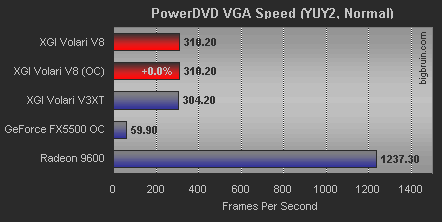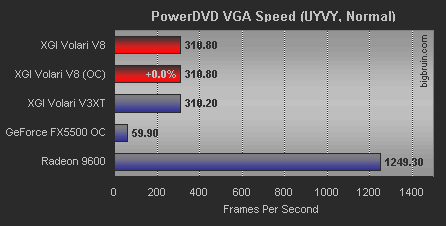| 256MB XGI Volari V8 AGP Card - Page 7 of 8 |
Benchmarking (continued):
ē PowerDVD VGA Speed:
Kind of an offbeat benchmark, this one is included with the PowerDVD software suite, and can be used to benchmark 2D performance, as experienced in DVD playback. The results below are from the 'YUY2, Normal' and 'UYVY, Normal' portions and are in terms of frames per second (fps). The V8 and V3XT hold a solid edge over the 5500 OC, but look weak in comparison to the Radeon. You really only need 30 fps for solid DVD playback, so such extreme numbers are not needed (higher is better)...


Price to Performance Comparison:
After having a look at the benchmarks, letís have a look at some of the specifications and pricing of the cards used in testing.
The table below lists some of the basic features and specifications of three of the cards tested in this review (256MB XGI Volari V8, 256MB BFG FX 5500 OC, and 128MB Sapphire Radeon 9600), as well as a 256MB Visiontek Radeon 9600. The Visiontek Radeon was included, although not tested, to provide a comparison with a 256MB version to the other 256MB cards used, since the Sapphire Radeon only sports 128MB of memory. Another difference is that the Sapphire Radeon is passively cooled, where as the Visiontek includes a heatsink and fan, like FX 5500 OC and Volari V8, which suggests a little more cost and greater performance potential.
| Model |
XGI Volari V8 |
BFG FX 5500 OC |
Sapphire Radeon 9600 |
Visiontek Radeon 9600 |
| Memory |
256MB DDR |
256MB DDR |
128MB DDR |
256MB DDR |
| Memory Speed |
201 MHz |
200 MHz |
200 MHz |
200 MHz |
| Core Clock Speed |
300 MHz |
290 MHz |
325 MHz |
325 MHz |
| HDTV Output? |
YES |
NO |
NO |
NO |
| MPEG-2 Decoder? |
YES |
NO |
NO |
NO |
| Tested? |
YES |
YES |
YES |
NO |
| Price |
@ $99 |
$134 |
$90 |
$125 |
From the data in the table above, a few things can be seen... All of the cards have roughly the same memory speed, and that extra one MHz from XGI gives it a paper victory in this category. All of the cards are also within the same range of core clock speeds and the performance edge seen in the review may be attributable to the 25 MHz edge held there. Other than the Volari V8, none of the cards include the added value, and multimedia appeal, of HDTV output or hardware MPEG-2 decoding, giving it an edge that may be more appealing to some than if it had dominated all of the benchmarks.
The final thing to analyze from the table above is the pricing of these cards. XGI is just now signing on distributors to bring their full line of cards to the US market, but estimated retail pricing for the 256MB version of the V8 can be expected to be under $99 US, and a 128MB version can be expected to sell for under $79 US. These prices make these cards highly competitive with the other cards tested, with the 256MB version of the V8 coming in about $35 less than the 256MB FX 5500 OC, and about $26 less than the 256MB Radeon 9600. The 128MB Radeon dominated the benchmarks, and cost a bit less than the V8 tested, making it the value of the bunch, but compare the price to the 128MB version of the V8 while considering the other multimedia features, and XGI is still able to keep things interesting.
Please read on to the next page for more... Next
Page 1 | Page 2 | Page 3 | Page 4 | Page 5 | Page 6 | Page 7 | Page 8
Home | Forum | Review Index
|
|
|
|